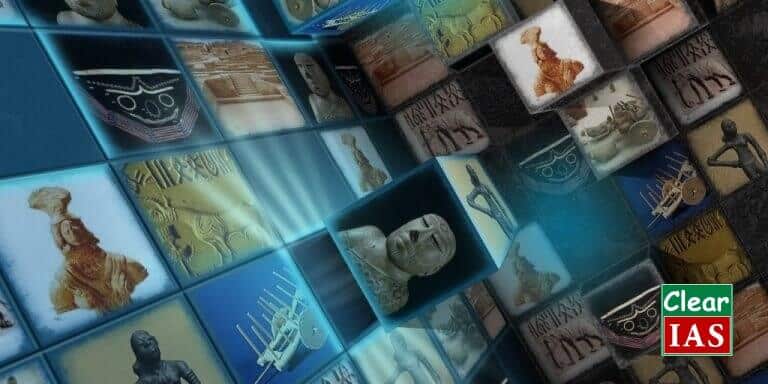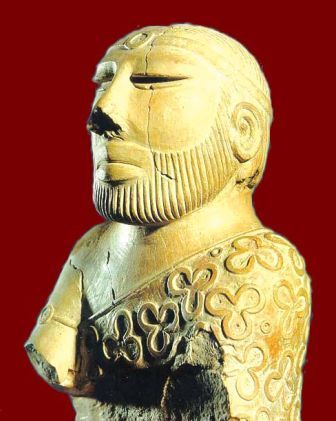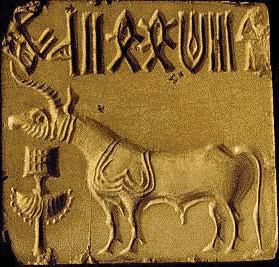32 Why Is Public Art Typically Made From Metal or Stone?
In this post, permit's come across the features of Indus Valley Civilisation arts as function of the Indian Civilization notes based on the NCERT text 'An Introduction to Indian Art' – Role 1. A detailed notation almost the features, sites, order, religion etc. of Indus Valley Civilization is already published in this website. As we have covered the prehistoric arts of India in the last article, we shall motion to the adjacent major era in the cultural history of Republic of india, ie. arts of Indus Valley.
Accept the ClearIAS UPSC prelims mock test on Indian civilisation. Yous not only volition learn the of import facts related to Indian culture, simply will also offset to honey the field of study!
Arts of Indus Valley Civilization

- The arts of Indus Valley civilisation, one of the earliest civilisations of the earth, emerged during the 2nd half of the third millennium (Bronze Age).
- The forms of art found from diverse sites of civilisation include sculptures, seals, pottery, aureate ornaments, terracotta figures, etc.
- Their delineation of human being and animal figures was highly realistic in nature.
- Modelling of figures was washed in an extremely conscientious mode.
- Ii major sites of Indus Valley civilisation, forth the river Indus are: North – cities of Harappa;South – Mohenjo-Daro.
- The site showcase ane of the primeval examples of civic planning.
- Houses, markets, storage facilities, offices, etc. arranged in a grid-like pattern.
- In this blueprint, roads were cut across 1 another in ninety-degree angle and the urban center was divided into blocks.
- There was also a highly developed drainage organization.
- While Harappa and Mohenjo-Daro are situated in Pakistan, the important sites excavated in India are:
- Lothal, Surkotada, Dholavira – Gujarat
- Rakhigarh and Banwali – Haryana
- Ropar – Punjab
- Kalibangan and Balatha – Rajasthan
Materials used: Stone, Bronze, Terra cotta, Dirt etc.
The arts of Indus valley which are excavated nonetheless are:
Rock Statues:
- Stone statues found in Indus valley sites are fantabulous examples of handling the 3D volume.
- Two major rock statues are:
- Bearded Man (Priest Homo, Priest-King)

- Plant in Mohenjo-Daro.
- Disguised human's figure made ofSteatite.
- The figure interpreted as a priest and is draped in a shawl coming under the right arm and covering the left shoulder.
- The shawl is busy with trefoil pattern.
- The optics are elongated and half airtight as in a meditative concentration.
- Olfactory organ is well formed and medium size.
- Brusk cutting moustache and a brusk beard and whiskers.
- Hair is parted in the middle and a evidently woven fillet is passed round the head.
- An armlet on the correct hand and holes around neck suggest necklace.
- A slight touch of the Greek mode of statues can be seen overall.
- Male Torso
- Found in Harappa (only major art element found in Harappa).
- Made of Ruddy Sandstone.
- In that location are socket holes in the neck and shoulders for the zipper of head and arms.
- Legs are broken.
- The shoulders are well baked and the abdomen slightly prominent.
- I of the well carved and finished piece of work.
Bronze Casting:
- Bronze casting was practiced in wide calibration in about all major sites of the culture.
- The technique used for Bronze Casting was Lost Wax Technique.
[Initially, the figure needed is made of wax and covered it with clay. After allowed to dry the clay, the whole thing is heated then that the wax inside the clay will exist melted. The molten wax was then drained out through a tiny hole made in the clay part. The hollow mold of dirt thus created was filled with molten metal. One time information technology cooled, the clay cover was completely removed].
- Human likewise every bit animal figures are present in the Bronze casting.
- Amongst animal figures the buffalo with its uplifted head, back and sweeping horns and the goat are artistic claim.
- Copper dog and bird of Lothal and the Bronze figure of a bull from Kalibangan shows that Bronze casting was popular at all centers of Indus valley culture.
- Metal casting connected even later the Indus valley civilization through late Harappan, Chalcolithic people, etc.
- Examples of Bronze casting are:
- Dancing Girl
- Constitute from Mohenjo-Daro.
- Made up of Statuary.
- One of the best-known artifacts from Indus valley.
- Approximately 4-inch loftier figure of a dancing girl.
- This exquisite casting depicts a girl whose long hair is tied in the bun and bangles comprehend her left arm.
- Cowry shell necklace is seen around her neck.
- Her correct hand is on her hip and her left hand is clasped in a traditional Indian trip the light fantastic toe gesture.
- She has large eyes and apartment nose.
- Balderdash from Mohenjo-Daro
- Bronze figure of the bull establish in Mohenjo-Daro.
- The massiveness of the bull and the fury of the charge are eloquently expressed.
- The animal is shown standing with his head turned to the right.
- At that place is a cord around the neck.
Terra cotta:
- Terracotta figures are more realistic in Gujarat sites and Kalibangan.
- In terracotta, we detect a few figurines of bearded males with coiled hairs, their posture rigidly upright, legs slightly apart, and the artillery parallel to the sides of the torso. The repetition of this figure in exactly the aforementioned position would propose that he was a deity.
- A terra cotta mask of a horned deity has also been found.
- Toy carts with wheels, whistles, rattles, bird and animals, gamesmen, and discs were likewise rendered in terracotta.
- The most important terracotta figures are those stand for Mother Goddess.
- Mother Goddess
- Mainly establish in Mohenjo-Daro.
- These figures are usually crude continuing figures.
- Adorned with necklaces hanging over the prominent breast and wearing a loin fabric and a grid.
- The fan-shaped headdress with a cup like projection on each side is a distinct decorative feature of the mother goddess.
- The pellet eyes and beaked nose of the figure are very crude (constructed in a rudimentary way).
- Mouth is indicated by a narrow opening.
Seals:

- Thousands of seals were discovered from the sites, usually fabricated of steatite, and occasionally of agate, chert, copper, faience and terracotta, with beautiful figures of animals such equally unicorn balderdash, rhinoceros, tiger, elephant, bison, goat, buffalo, etc.
- The purpose was mainly commercial.
- They were also used as amulets, carried on the persons of their owners, perhaps as mod identity cards.
- Standard Harappan seal was 2 x two square inches.
- Every seal is engraved in a pictographic script which is yet to be deciphered.
- Some seals were also been constitute in Aureate and Ivory.
- Seals of Pashupati Mahadeva
- Found in Mohenjo-Daro.
- The seal depicts a human effigy seated cantankerous legged.
- An elephant and a tiger are depicted to the right side of the effigy, while on the left a rhinoceros and a buffalo are seen.
- 2 antelopes (deer) are shown below the seat (nearby his feet).
- The figure has a three horned head.
Pottery:
- Indus valley pottery consists of very fine bike made wares, very few being handmade.
- Manifestly pottery is more common than painted ware.
- Obviously pottery is generally red clay, with or without a fine red or grey slip.
- The blackness painted ware has a fine blanket of red slip on which geometric and animal designs are executed in glossy black paint.
- Painted Earthen Jar
- Found in Mohenjo-Daro.
- Fabricated on a potters' wheel with clay.
- The shape was manipulated by force per unit area of the crafty fingers of the potter.
- Later baking a dirt model, it was painted with blackness colour.
- High polishing was done every bit a finishing bear upon.
- Motifs are vegetal and geometric forms.
- Designs are simple.
Chaplet, Ornaments and Cosmetics:
- The Harappan men and women decorated themselves with a large diverseness of ornaments produced from every conceivable materials ranging from precious metals and gemstones to bone and baked clay.
- White necklaces, fillets, armlets and finger rings were ordinarily worn by both sexes.
- Jewellery found at Mohenjo-Daro and Lothal include necklaces of gold and semiprecious metal stones, copper bracelets and beads, gold earrings and head ornaments.
- A cemetery has been found at Farmona in Harappa where expressionless bodies were cached with ornaments.
- Well developed bead industries were nowadays at Chauhudaro and Lothal.
- Some beads were made of 2 or more than stones cemented together.
- Also fabricated models of animals, especially monkeys and squirrels, used equally pin head and beads.
- Spinning of cotton and wool was very mutual (both rich and poor practiced spinning).
- Men and women wore 2 separate pieces of attire similar to dhoti and shawl.
- Shawl covered the left shoulder passing below right arm.
- They were conscious of fashion.
- Dissimilar pilus styles were in vogue and bristles was popular.
- Cinnabar was used as a corrective and face up-paint, lipstick and collyrium (eyeliner) were besides known to them.
Compiled by Jijo Sudashan
Reader Interactions
Source: https://www.clearias.com/arts-indus-valley-civilization/


0 Response to "32 Why Is Public Art Typically Made From Metal or Stone?"
Post a Comment